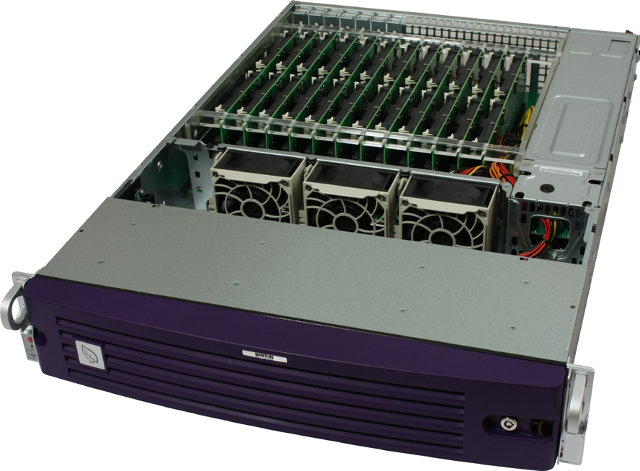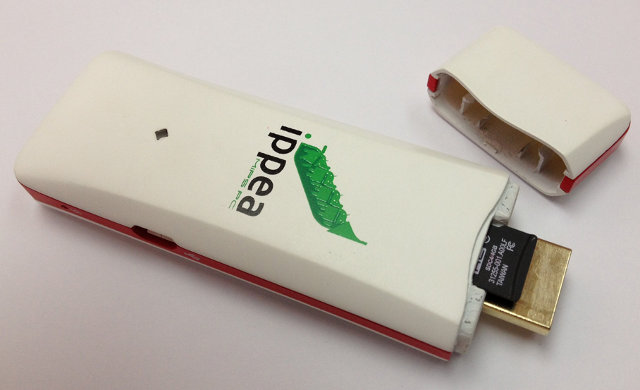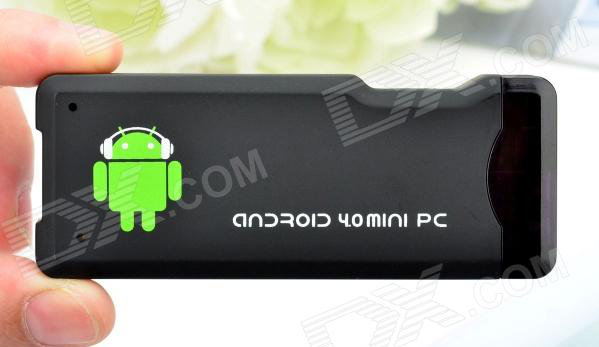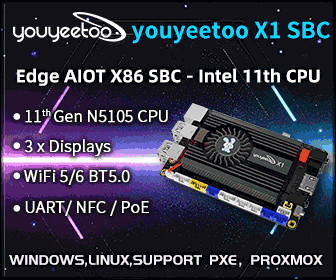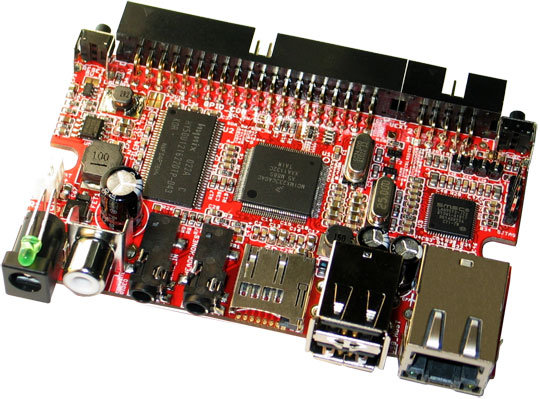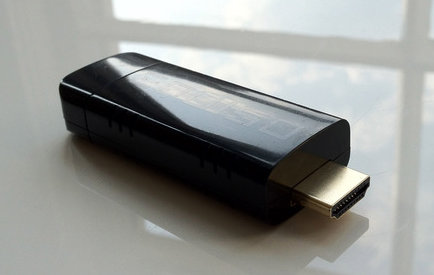At the end of 2011, Boston, a British IT company, announced plans for an ARM server based on Calxeda Quad Core Cortex A9 Server-on-Chip, and now the company recently announced they started to ship the server (called Viridis) to their first customers. We now have further details about the server including the key features: Ten times the performance at the same power in the same space Cut energy and space by 90% Easily scalable to thousands of nodes 48 SoC devices delivered across 12 Calxeda EnergyCard modules Each EnergyCore SoC contains an ARM quadcore processing unit, providing a total of 192 cores per 2U enclosure Low power consumption: <300W with each SoC consuming between 0.5 to 5W depending on the load. Up to 24 SATA HDDs or SSD devices Up to 192GB of RAM per 2U enclosure A Calxeda EnergyCard (pictured below) features 4 Calxeda EnergyCore ECX-1000 SoC which can […]
Ramos Miumiu W1 Android 4.0 Tablet Based on Actions ATM7019 MIPS SoC
Ramos Miumiu W1 is a tablet running Android 4.0 (ICS) and powered by Actions Semiconductor’s ATM7019 SoC that integrate a MIPS32 74Kf core running at 1 GHz. Actions Semiconductor is a Chinese fabless semiconductor company headquartered in Zhuhai (like AllWinner). Here are the specs of the devices: SoC – Actions Semiconductor ATM7019 MIPS32 74Kf Core @ 1GHz System Memory – 512 MB DDR3 RAM Storage – 4GB or 8GB Flash depending on model + microSD slot Display – 7″ WSVGA (1024×600) capacitive touch screen. Connectivity – Wifi 802.11b/g/n USB – micro USB 2.0 Video Output – HDMI The processor can support 1080p HD video playback and the tablet can record 640×480 video via the front camera. Actions Semiconductor does not provide information about ATM7019 SoC on their website, but I found a 2011 presentation hosted on MIPS website that explains some details about MIPS32 74Kf based processors by Actions SemiConductor […]
iPPea TV Android 4.0.3 HDMI Stick Based on Ingenic JZ4770 (MIPS) Sells for 50 USD
iPPea Inc announced iPPea TV, an Android 4.0 dongle based on Ingenic JZ4770 MIPS SoC that “brings the ‘smart’ Android experience to any HDMI-enabled DTV for $50 US”. This is the first MIPS based Android mini PC that I’ve seem among all the ARM based floating around. Here are iPPea TV specifications: Ingenic JZ4770 applications processor (MIPS-Based XBurst CPU) @ 1.2 GHz. 2GB storage with support for up to 32 GB external storage via a microSD slot. 512 MB of DDR2 RAM HDMI ouput (up to 1080p) 802.11b/g/n Wifi USB 2.0 port and micro USB 2.0 OTG port Video format – AVI,MKV(XVID/px/H.264),MOV,TS,M2TS, RM/RMVB,FLV,3GP,MPEG,DAT,MP4 Audio format – AAC, AAC+, eAAC+, AMR-NB, AMR-WB, QCP, MP3, WMA, WAV, MIDI, M4A Picture format – GIF, BMP, JPEG, PNG Ebook format: PDF,EPUB,HTML,TXT Dimensions – PCB: 80 mm x 20mm x 6.5 mm | mini PC: As small as 95.5 mm x 31.5 mm x 12 […]
Android 4.1.1 Jelly Bean Source Code Released
Jean-Baptiste Queru, Android Open Source Project lead, announced that Android 4.1.1, Jelly Bean has been released to AOSP and uses the android-4.1.1_r1 tag. Proprietary binaries are available for Nexus 7 and Galaxy Nexus right now, and Nexus S (GSM and CDMA) and Xoom will be available later. If AOSP repo has not changed since the first Android 4.0 release, you should be able to get the source as follows:
|
1 2 |
repo init -u https://android.googlesource.com/platform/manifest -b android-4.1.1_r1 repo sync |
There is also a development branch (jb-dev) with the latest improvements and features. Once you get the code, you may want to build and run it. Instructions to build and run Android 4.0 (not yet updated to Android 4.1.1 with Galaxy Nexus 7) are available at http://source.android.com/source/building.html. Factory images for Android 4.1.1 for Nexus devices will eventually show up at https://developers.google.com/android/nexus/images
72.90 USD AK802 Android Mini PC with AllWinner A10 and 1GB RAM
No, it’s not a typo in the title, and I did not mean to write “MK802”, but a company (which does not appear to be Rikomagic) released a product called AK802 which looks very similar (not to say exactly) the same, but comes with 1GB by default. Here are the specifications of the device partially taken from Dealextreme, so there must be an error somewhere, we just need to find out where ;). CPU AllWinner A10 @ 1.5GHz + Mali 400 GPU Memory 1 GB RAM Storage 4 GB Flash microSD slot (Up to 32 GB) Connectivity WiFi 802.11b/g USB micro USB 2.0/OTG port USB 2.0 Host port Video output HDMI (up to 2160p) Video Codecs & Containers WMV, ASF, MP4, 3GP, 3G2M4V, AVI, MJPEG, RV10, DivX/VC-1, MPEG-2, MPEG-4, H.263, H.264/1280*720P HD 30 fps, 1080P/720*480 D1 30fps Audio Codecs AAC, AAC+, eAAC+, AMR-NB, AMR-WB, QCP, MP3, WMA, WAV, MIDI, M4A […]
Jolla Smartphones To Run Meego (Born Again) Operating System
I saw a tweet about Jolla 2 days ago, but did not pay much attention because there was no info available. And to some extend, there isn’t much more info now, but a lot of hype about Jolla, a Finnish company recently founded and composed of ex-Nokia employees that aims to design, develop and sell smartphones based on the (thought-to-be-dead) Meego operating system. Jolla’s Meego will be based on the Mer Project & Qt and will feature a “brand new UI” designed by Jolla. The company has been working on the phone since late 2011 and a demo will be available later this year. You can follow the company on LinkedIn or Twitter, as it does not have a website yet.
Olimex Offers Up to 50% Discount on OLinuXino Boards to Open Source Developers
Olimex has been providing low cost MCU devkits for many years, and this year they started offering more powerful embedded Linux development boards called OLinuXino. The first family (iMX233-OLinuXino) is based on Freescale i.MX233 ARM9 processor @ 454 Mhz and comes in three form factor: iMX233-OLINUXINO-MAXI – 2x USB host, Ethernet, TV-out, GPIOs, SD-CARD, Audio-In, Audio-Out, UEXT – 44.95 Euros. iMX233-OLINUXINO-MINI – 3x USB host, TV-out, GPIOs, SD-CARD, Audio-In, Audio-Out, UEXT – 34.95 Euros iMX233-OLINUXINO-MICRO – USB host, TV-out, GPIOs, SD-CARD, ready for breadboaring – 23.95 Euros They are also working on A13-OLinuXino board featuring AllWinner A13 Cortex A8 processor. To promote their new boards (and reward open source developers – cf comment below), the company company has decided to offer discount to open source developers. The way I understand it: you need to buy a board first, publish the source code somewhere and write about it on your own […]
Equiso Smart TV: 69 USD Android mini PC with Wireless Remote
Here’s yet another Android mini PC HDMI Stick. Equiso has started a KickStarter compaign to raise funds to complete development and manufacture the Equiso Smart TV, an Android mini PC based on Telechips TCC8925 Cortex A5 processor. It looks very similar to CX-01 mini PC with Android 4.0 running on a TCC8925 processor, 512 MB RAM and the lack of a microSD card slot. The only hardware differences are that it includes 8GB internal storage (vs 4GB for CX-01), and it features an HDMI 1.4 port (vs 1.3 for others). Here are the specs of the device: Telechips TCC8925 Arm Cortex A5 Processor @ 1GHz + Mali 400 3D Graphics Processor 512 MB DDR3 RAM 802.11 N wireless radio 8 GB Memory Internal (WiFi) 1.4 HDMI Plug n’ Play Interface, 3D, ESD protection, CEC USB 2.0 port microUSB 2.0 port to power the device Dimensions – 80mm x 30mm x […]


